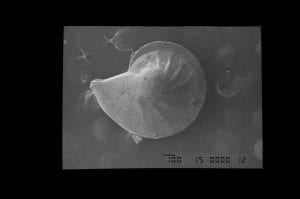 Foraminifera (or foram for short) means “hole bearers” in Latin. Foram are part of the ameboid protist class in the kingdom protista, meaning they’re single-celled organisms that are not plant, animal or fungi. 100 million years ago these tiny critters populated in the ancient oceans. Fifty thousand species scoured the sea floors and floated above the underwater plains.
Foraminifera (or foram for short) means “hole bearers” in Latin. Foram are part of the ameboid protist class in the kingdom protista, meaning they’re single-celled organisms that are not plant, animal or fungi. 100 million years ago these tiny critters populated in the ancient oceans. Fifty thousand species scoured the sea floors and floated above the underwater plains.
Honors graduate and Torgeson Bridge fellow Laura Cruz-Gomez investigates foram fossils from the age of the dinosaurs. This was the Creteacous period — when parts of Texas were under a shallow sea. While one fifth of foram species still exist, there’s still more to learn about how the ancient foram lived.
Laura said these microfossils closely resemble seashells,  except they’re smaller.
except they’re smaller.
“Really, really small,” she said. “I just study the shell, what’s left — the calcium carbonate shell that is preserved.”
The foram come in diverse shapes and sizes. Some are rounded and globular while others are spiraled and still others are conical in form. The largest can be the size of 20 cm. The smallest looks like a grain of sand. They’re especially abundant within the Paw Paw formation which is a layer of exposed rock in parts of North Texas from Denton County down near I-30 in Fort Worth and Arlington.
- Nodosaria obscura Reuss
- Vaginulina kochii Romer
- Vaginulina complanata (Reuss)
- Lenticulina sp.
- Muricohedbergella delrioensis (Carsey)
- Ramulina sp.
Laura said her interest in studying these organisms stems from her appreciation of biology and geology. It was during a field study trip to Hawaii seven years ago that she became fascinated with rock formations. Originally, she was focused on studying local wildlife on her trip.
“But then I was fascinated by this concept of plate tectonics, particularly with hot spots,” she said.
When she came to UTA, she enrolled in a paleontology course which peaked her interests that led to her current research.
Laura graduated with Honors in 2014 and received the G. Irene and Fernando G. Torgerson Bridge fellowship in 2015 to fund her work. Her tasks specifically entail the extensive process of filtering fossils from rock and detailing each spec of organism using a scanning electron microscope, that super-magnifies the image resolution. The document of foram species, which is continually updated, will be useful for future research.
Once she completes her work this summer, Laura hopes to go take some time off to teach science at a high school or community college before she enrolls in a PhD program.







Great work, Laura! Keep it up!